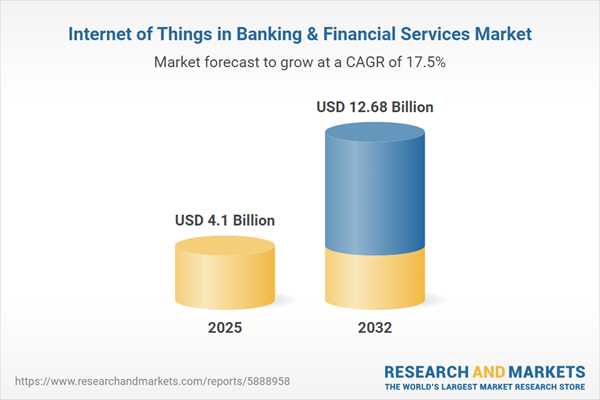Speak directly to the analyst to clarify any post sales queries you may have.
The Internet of Things in Banking & Financial Services market is redefining digital transformation for financial institutions. By leveraging connected devices, organizations are streamlining operations, strengthening customer engagement, and enhancing risk management with a holistic approach to technology integration.
Market Snapshot: IoT in Banking & Financial Services
The Internet of Things in Banking & Financial Services Market grew from USD 3.49 billion in 2024 to USD 4.10 billion in 2025. It is projected to increase at a CAGR of 17.49%, reaching USD 12.68 billion by 2032. This growth is powered by expanding cloud-native IoT infrastructures and expanding adoption of advanced analytics, creating new opportunities for real-time transaction monitoring, personalized financial products, and resilient digital ecosystems in the sector.
Scope & Segmentation
- Component: Hardware (gateways, sensors, wearables), Services (integration, managed, support and maintenance), Software (analytics, platform, security software)
- Connectivity Technology: Cellular (3G and 2G, 4G, 5G), LPWAN (LoRaWAN, NB-IoT, Sigfox), Satellite, Short Range (Bluetooth, NFC, Wi-Fi)
- Application: Asset tracking (cash tracking, vehicle telematics), Customer analytics (behavior analytics, segmentation analytics), Fraud management (biometric authentication, real-time analytics), Payment solutions (contactless, mobile), Risk management (credit, operational)
- End User: Banks, fintech firms, insurance companies
- Region: Americas (United States, Canada, Mexico, Brazil, Argentina, Chile, Colombia, Peru), Europe, Middle East & Africa (including United Kingdom, Germany, France, Russia, Italy, Spain, Netherlands, Sweden, Poland, Switzerland, United Arab Emirates, Saudi Arabia, Qatar, Turkey, Israel, South Africa, Nigeria, Egypt, Kenya), Asia-Pacific (China, India, Japan, Australia, South Korea, Indonesia, Thailand, Malaysia, Singapore, Taiwan)
- Key Players: Amazon Web Services, Microsoft, IBM, Google, Cisco, Oracle, SAP, PTC, Software AG, Hitachi Vantara
Key Takeaways for Senior Decision-Makers
- The Internet of Things in Banking & Financial Services market empowers institutions to deliver hyper-personalized services and data-driven customer engagement through real-time device data and advanced analytics.
- Integration of cloud-native and modular IoT architectures enables scalable, future-ready deployments that support rapid innovation in payment solutions, risk management, and branchless banking.
- Emerging connectivity standards, including 5G, LPWAN, and satellite technologies, are strengthening ecosystem resilience, supporting secure mobile payments and robust fraud detection capabilities across varied environments.
- Collaboration between banks, fintechs, and technology vendors is accelerating the co-creation of customized IoT solutions—driving quicker deployment of new offerings and expanding digital service footprints.
- Wearable devices, smart terminals, and sensor-based infrastructures are enhancing operational efficiency and automated authentication, reshaping how financial organizations interact with customers and manage assets.
Tariff Impact: Strategic Procurement Adjustments
The introduction of United States tariffs on imported electronic components in 2025 is compelling banks and technology vendors to reassess supply chains, realign sourcing strategies, and renegotiate supplier contracts. Institutions are adapting by diversifying manufacturing bases, incorporating cost volatility into procurement cycles, and evaluating technology choices through a risk-adjusted lens. These strategies are intended to maintain operational continuity and safeguard investment planning against tariff-driven disruptions.
Methodology & Data Sources
This report draws insights from an exhaustive blend of secondary research—including regulatory documents, white papers, and technical releases—combined with primary interviews conducted among C-level executives, IT leaders, and regulatory specialists. Quantitative analysis identified deployment trends and validated findings through expert panel review, achieving credible and actionable outcomes.
Why This Report Matters
- Provides a clear roadmap for leveraging IoT innovations to optimize financial operations, customer engagement, and risk assessment.
- Equips decision-makers with strategic insights for navigating technology selection, regulatory obligations, and supply chain complexities in a dynamic global market.
Conclusion
IoT technologies are shaping the next phase of digital transformation for banking and financial services. By aligning technology investments with robust security and collaborative strategies, institutions can secure long-term growth and operational agility in digital finance.
Additional Product Information:
- Purchase of this report includes 1 year online access with quarterly updates.
- This report can be updated on request. Please contact our Customer Experience team using the Ask a Question widget on our website.
Table of Contents
3. Executive Summary
4. Market Overview
7. Cumulative Impact of Artificial Intelligence 2025
Companies Mentioned
The companies profiled in this Internet of Things in Banking & Financial Services market report include:- Amazon Web Services, Inc.
- Microsoft Corporation
- International Business Machines Corporation
- Google LLC
- Cisco Systems, Inc.
- Oracle Corporation
- SAP SE
- PTC Inc.
- Software AG
- Hitachi Vantara LLC
Table Information
| Report Attribute | Details |
|---|---|
| No. of Pages | 193 |
| Published | November 2025 |
| Forecast Period | 2025 - 2032 |
| Estimated Market Value ( USD | $ 4.1 Billion |
| Forecasted Market Value ( USD | $ 12.68 Billion |
| Compound Annual Growth Rate | 17.4% |
| Regions Covered | Global |
| No. of Companies Mentioned | 10 |









